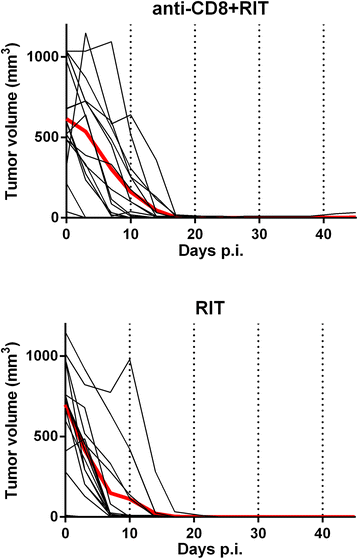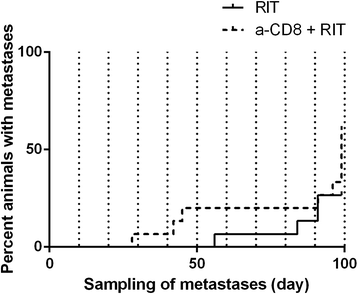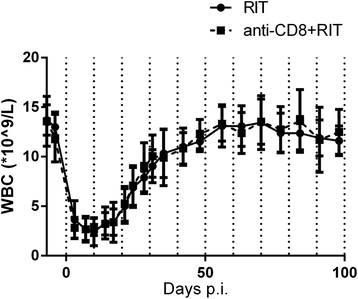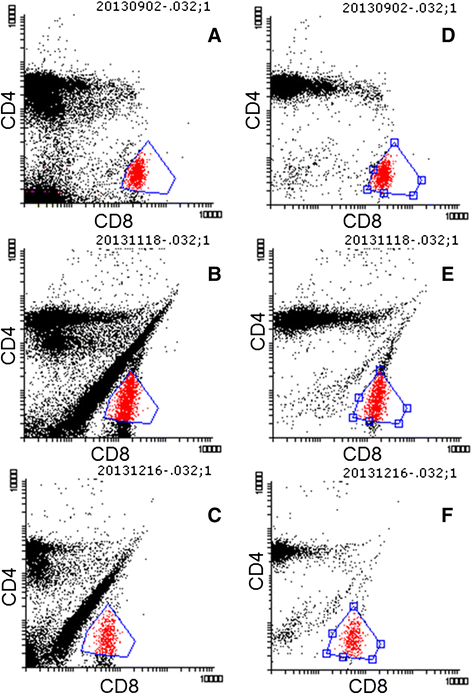Role of CD8-positive cells in radioimmunotherapy utilizing (177)Lu-mAbs in an immunocompetent rat colon carcinoma model
- PMID: 25853009
- PMCID: PMC4385015
- DOI: 10.1186/s13550-014-0079-6
Role of CD8-positive cells in radioimmunotherapy utilizing (177)Lu-mAbs in an immunocompetent rat colon carcinoma model
Abstract
Background: CD8-positive cells might play a crucial role in the therapeutic response to radiation, which has however not been investigated in radioimmunotherapy (RIT). The aim of this study was to evaluate whether cytotoxic T cells affect the response of established tumors and, above all, if they delay or prevent the development of distant metastases after RIT, using an immunocompetent syngeneic rat colon carcinoma model.
Methods: The cytotoxic T cells were depleted in 15 rats by anti-CD8 before the injection of the radioimmunoconjugate (400 MBq/kg body weight (177)Lu-BR96, which binds to the tumor-associated antigen Lewis Y). Fifteen other rats were treated with RIT only. Both groups were followed for 99 days. Blood samples were collected at least once weekly, and tumors were monitored twice weekly.
Results: Twenty-nine of the 30 animals exhibited local complete response. The non-responder was treated with anti-CD8 and RIT but succumbed later due to metastases. Five animals in the group given anti-CD8 + RIT were sacrificed due to metastatic disease, and 4 additional animals were found to have metastases at autopsy. In the group given RIT, 4 animals developed metastatic disease, but no metastases were found in the remaining 11 animals at autopsy. Thus, at the end of the study, 6 animals in the anti-CD8 + RIT group were free from metastases, while 11 were free from metastases in the group receiving RIT. CD3(+)CD4(-)CD8(+) lymphocytes were consistently depleted by the anti-CD8 treatment. The myelosuppression was otherwise similar in the two groups. The initial depletion of CD8-positive cells in our syngeneic rat colon carcinoma model resulted in a higher frequency of animals developing metastases.
Conclusions: Depletion of CD8-positive cells during RIT in an immunocompetent rat tumor model might influence the number of animals developing metastases, indicating that the immune system may be important in the long-term outcome of RIT.
Keywords: CD8 depletion; Cytotoxic T cells; Immunocompetent animal model; Metastases; Radioimmunotherapy.
Figures





Similar articles
-
Evaluation of immune cell markers in tumor tissue treated with radioimmunotherapy in an immunocompetent rat colon carcinoma model.EJNMMI Res. 2015 Dec;5(1):47. doi: 10.1186/s13550-015-0126-y. Epub 2015 Sep 15. EJNMMI Res. 2015. PMID: 26374556 Free PMC article.
-
Repeated radioimmunotherapy with 177Lu-DOTA-BR96 in a syngeneic rat colon carcinoma model.Cancer Biother Radiopharm. 2012 Mar;27(2):134-40. doi: 10.1089/cbr.2011.1080. Epub 2012 Jan 9. Cancer Biother Radiopharm. 2012. PMID: 22229635
-
Treatment with unlabeled mAb BR96 after radioimmunotherapy with 177Lu-DOTA-BR96 in a syngeneic rat colon carcinoma model.Cancer Biother Radiopharm. 2012 Apr;27(3):175-82. doi: 10.1089/cbr.2011.1132. Epub 2012 Mar 14. Cancer Biother Radiopharm. 2012. PMID: 22417248
-
Radioimmunotherapy of colorectal cancer liver metastases: combination with radiotherapy.Ann N Y Acad Sci. 2000 Jun;910:263-9; discussion 269-70. doi: 10.1111/j.1749-6632.2000.tb06714.x. Ann N Y Acad Sci. 2000. PMID: 10911919 Review.
-
Combination Radioimmunotherapy Strategies for Solid Tumors.Int J Mol Sci. 2019 Nov 8;20(22):5579. doi: 10.3390/ijms20225579. Int J Mol Sci. 2019. PMID: 31717302 Free PMC article. Review.
Cited by
-
Evaluation of immune cell markers in tumor tissue treated with radioimmunotherapy in an immunocompetent rat colon carcinoma model.EJNMMI Res. 2015 Dec;5(1):47. doi: 10.1186/s13550-015-0126-y. Epub 2015 Sep 15. EJNMMI Res. 2015. PMID: 26374556 Free PMC article.
References
LinkOut - more resources
Full Text Sources
Other Literature Sources
Research Materials
Miscellaneous

